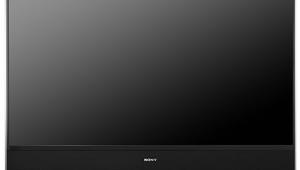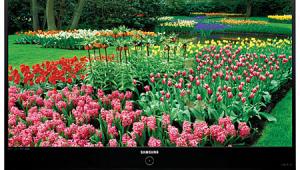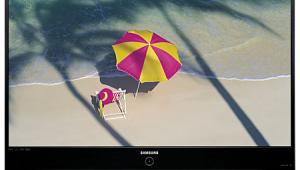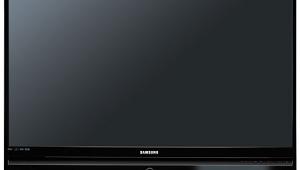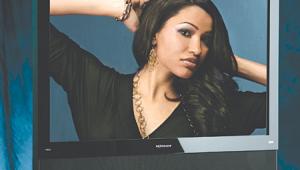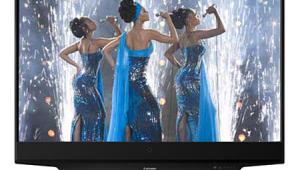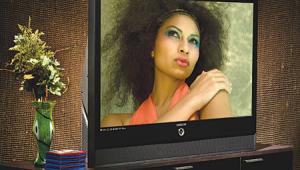Samsung HL-S5679W DLP Rear Projection Television Page 2
 The on-screen Picture Control menus offer the usual variety of Modes, in this case designated Dynamic, Standard, Movie, or Custom. The control settings for each of these may be individually adjusted by the user. But some mode selections omit some of the controls. I preferred the Movie mode, which does not, for example, offer Samsung's DNIe image enhancement feature. But this omission was fine by me, as you'll read later.
The on-screen Picture Control menus offer the usual variety of Modes, in this case designated Dynamic, Standard, Movie, or Custom. The control settings for each of these may be individually adjusted by the user. But some mode selections omit some of the controls. I preferred the Movie mode, which does not, for example, offer Samsung's DNIe image enhancement feature. But this omission was fine by me, as you'll read later.
The Samsung's menus offer three different sets of specialized color controls (apart from Color and Tint). Color Tone is a color temperature control with five settings: Cool1, Cool2, Warm1, Warm2, and Normal. The "My Color Control" selection is one of those control sets that offer control over the intensity of five different colors: red, green, blue, yellow, and pink (in the control's "Detail Control" option) or, alternately, seven preset options. Although it would be nice to see the results of these adjustments while you're actually viewing the program material you want to watch, the control does not allow that. You can only make these changes while watching a pre-set, still image.
There's also something called a "Color Weakness" control in the setup menu that offers red, green, and blue adjustments to "compensate for the user's particular color weakness." That's what the manual says. Perhaps this is the color blind control? In any case, I used the "My Color Control" very little, and didn't use the "Color Weakness" controls at all.
There is a Film Mode control with On and Off settings. My tests indicated that the On position actually appeared to be an auto-detect position, which provided the best results with both film- and video-based sources. This control is not available in the Movie mode.
There are other commonly seen features as well, including all the different aspect ratio settings you'll need, picture-in-picture, Still (freeze frame), parental control with V-Chip, and the TV Guide On Screen program guide. Not so common is a USB input on the rear side of the set for viewing JPEG files or listening to MP3 files saved on a USB mass storage device such as a USB (thumb) drive or a Flash Card reader. There is also a Game setting in the Setup menu (separate from any of the video mode settings discussed earlier).
The built-in audio system also offers a range of controls, including Auto Volume (for damping down those aggressive commercials), a variety of equalization options, and SRS—the latter providing, to quote the manual, a "compelling, virtual surround sound experience through any two-speaker playback system, including internal television speakers." The on board sound is better than you'll hear from most flat panel displays, and is adequate for casual viewing. But if you want a compelling surround sound experience, use a good external 5.1-channel audio system. But you already knew that.
The Samsung, as with all current rear projection 1080p DLP sets, uses one of TI's latest "wobulated" 1080p DMDs (Digital Micromirror Devices). That is, the native resolution of the chip is actually 960x1080, but the image is shifted horizontally every 1/120th of a second to produce 1920x1080 pixels on the screen for every source frame. The set will accept native 1080p/60 video sources, as well as 480i/p, 720p, and 1080i programming.
Turning It On
Unlike all sets built around a projection lamp, which require a slow warm-up, the PhlatLight-equipped Samsung turns on almost instantaneously. And although it does have a fan, it does not require a fan-cooled shutdown period before turning off. This not only eliminates an operating nuisance, but also the risk that an expensive projection lamp will be damaged if the set shuts down during a power failure.
The LED-based lighting system also offers other advantages. The light elements should last the life of the set. PhlatLight suggests 20,000 hours. That's over nine years at a heavy usage rate of six hours per day, 365 days per year. Assuming 2,000 hours of life from a $350 projection lamp, a lamp based set would require nine replacements over those same years—a cost of over $3000, not including sales tax. That makes the price premium commanded by the HL-S5679W look a little less intimidating (about $700 over the cost of the company's top, lamp-based 56" model).
Keep in mind that the elimination of the color wheel made possible by the red, green, and blue LEDs does not automatically mean the elimination of the rainbow effect that has been a bane of single-chip DLP devices since their inception (but is less troublesome now than in the past). With a single imaging chip, the red, green, and blue LEDs still have to flash sequentially to produce a full-color image. But they apparently flash much faster than is possible with a color wheel (LEDs can turn off and on in microseconds).
I can vouch for the fact that you're very unlikely to see rainbows with this set. I didn't see any at all. I'm very sensitive to them, but perhaps there's a Rainbow Superman out there who can see them all the time (except through lead, of course). So I'll never say never.
- Log in or register to post comments



